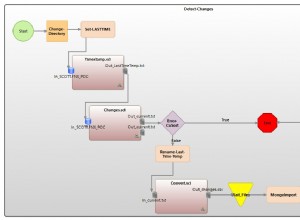Per un'implementazione UDF della Distanza di Levenshtein algoritmo che potresti voler controllare "codejanitor.com:Levenshtein Distance come funzione memorizzata MySQL ":
CREATE FUNCTION LEVENSHTEIN (s1 VARCHAR(255), s2 VARCHAR(255))
RETURNS INT
DETERMINISTIC
BEGIN
DECLARE s1_len, s2_len, i, j, c, c_temp, cost INT;
DECLARE s1_char CHAR;
DECLARE cv0, cv1 VARBINARY(256);
SET s1_len = CHAR_LENGTH(s1), s2_len = CHAR_LENGTH(s2), cv1 = 0x00, j = 1, i = 1, c = 0;
IF s1 = s2 THEN
RETURN 0;
ELSEIF s1_len = 0 THEN
RETURN s2_len;
ELSEIF s2_len = 0 THEN
RETURN s1_len;
ELSE
WHILE j <= s2_len DO
SET cv1 = CONCAT(cv1, UNHEX(HEX(j))), j = j + 1;
END WHILE;
WHILE i <= s1_len DO
SET s1_char = SUBSTRING(s1, i, 1), c = i, cv0 = UNHEX(HEX(i)), j = 1;
WHILE j <= s2_len DO
SET c = c + 1;
IF s1_char = SUBSTRING(s2, j, 1) THEN SET cost = 0; ELSE SET cost = 1; END IF;
SET c_temp = CONV(HEX(SUBSTRING(cv1, j, 1)), 16, 10) + cost;
IF c > c_temp THEN SET c = c_temp; END IF;
SET c_temp = CONV(HEX(SUBSTRING(cv1, j+1, 1)), 16, 10) + 1;
IF c > c_temp THEN SET c = c_temp; END IF;
SET cv0 = CONCAT(cv0, UNHEX(HEX(c))), j = j + 1;
END WHILE;
SET cv1 = cv0, i = i + 1;
END WHILE;
END IF;
RETURN c;
END
Ora costruiamo un test case, utilizzando i dati che hai fornito nella tua domanda:
CREATE TABLE table_a (name varchar(20));
CREATE TABLE table_b (name varchar(20));
INSERT INTO table_a VALUES('Olde School');
INSERT INTO table_a VALUES('New School');
INSERT INTO table_a VALUES('Other, C.S. School');
INSERT INTO table_a VALUES('Main School');
INSERT INTO table_a VALUES('Too Cool for School');
INSERT INTO table_b VALUES('Old School');
INSERT INTO table_b VALUES('New ES');
INSERT INTO table_b VALUES('Other School');
INSERT INTO table_b VALUES('Main School');
INSERT INTO table_b VALUES('Hardknocks School');
Quindi:
SELECT *
FROM table_a a
LEFT JOIN table_b b ON (a.name = b.name);
Ovviamente restituisce una corrispondenza in cui i nomi delle scuole corrispondono esattamente:
+---------------------+-------------+
| name | name |
+---------------------+-------------+
| Olde School | NULL |
| New School | NULL |
| Other, C.S. School | NULL |
| Main School | Main School |
| Too Cool for School | NULL |
+---------------------+-------------+
5 rows in set (0.00 sec)
Ora possiamo provare a utilizzare il LEVENSHTEIN funzione per restituire i nomi delle scuole che hanno una distanza di modifica
di 2 caratteri o meno:
SELECT *
FROM table_a a
LEFT JOIN table_b b ON (LEVENSHTEIN(a.name, b.name) <= 2);
+---------------------+-------------+
| name | name |
+---------------------+-------------+
| Olde School | Old School |
| New School | NULL |
| Other, C.S. School | NULL |
| Main School | Main School |
| Too Cool for School | NULL |
+---------------------+-------------+
5 rows in set (0.08 sec)
Ora usando <= 3 come soglia di distanza di modifica:
SELECT *
FROM table_a a
LEFT JOIN table_b b ON (LEVENSHTEIN(a.name, b.name) <= 3);
Otteniamo il seguente risultato:
+---------------------+--------------+
| name | name |
+---------------------+--------------+
| Olde School | Old School |
| Olde School | Other School |
| New School | Old School |
| Other, C.S. School | NULL |
| Main School | Main School |
| Too Cool for School | NULL |
+---------------------+--------------+
6 rows in set (0.06 sec)
Nota come questa volta Olde School corrispondeva anche a Other School e New School corrispondeva a Old School anche. Questi sono probabilmente falsi positivi e mostrano che la definizione della soglia è molto importante per evitare corrispondenze errate.
Una tecnica comune per affrontare questo problema consiste nel prendere in considerazione la lunghezza delle stringhe quando si applica una soglia. In effetti, il sito che Ho citato per questa implementazione
fornisce anche un LEVENSHTEIN_RATIO funzione che restituisce il rapporto (in percentuale) della differenza di modifica in base alla lunghezza delle stringhe.




